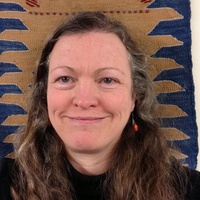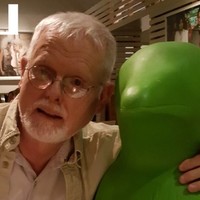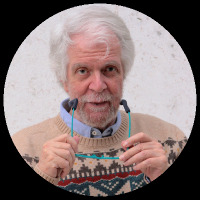
Antonis Katsarakis
Αντώνης Γ. Κατσαράκης - Βιογραφικό Σημείωμα
Antonis G. Katsarakis - Curriculum Vitae
e-mail: katsarak1968@gmail.com
2024, MA στην Οθωμανική Ιστορία, Πανεπιστήμιο Κρήτης (Διιδρυματικό Πρόγραμμα Μεταπτυχιακών Σπουδών «Οθωμανική Ιστορία» του Τμήματος Ιστορίας και Αρχαιολογίας του Πανεπιστημίου Κρήτης και του Ινστιτούτου Μεσογειακών Σπουδών του Ιδρύματος Τεχνολογίας και Έρευνας). Τίτλος μεταπτυχιακής εργασίας «Η δυνατότητα ανασύστασης των οικοπέδων του βενετικού Χάνδακα με βάση την καταγραφή του οθωμανικού απογραφικού καταστίχου TT 798 του 1669». / ΜΑ in Ottoman History (Graduate Program in Ottoman History of the Department of History and Archaeology of the University of Crete and the Institute for Mediterranean Studies of the Foundation for Research and Technology). Dissertation title: «The possibility of reconstructing the parcellation of Venetian Candia, based on the 1669 Ottoman census register TT 798»
2020 Phd, Σχολή Αρχιτεκτόνων Ε.Μ.Π. με θέμα διδακτορικού "Η αρχιτεκτονική του Μαρουλά Ρεθύμνου - Οι μετασχηματισμοί μιας παράδοσης, 1620-1820", επιβλέπων Ι. Κίζης. / Phd, School of Architecture, National Technical University of Athens, "Τhe architecture of Maroulas in Crete, Greece - Transformations of a Tradition, 1620-1820", supervisor I. Kizis.
2016, απόφοιτος της Σχολής Τουρκικών και Σύγχρονων Ασιατικών Σπουδών του Eθνικού & Καποδιστριακού Πανεπιστημίου Αθηνών. / Graduate of the Faculty of Turkish Studies and Modern Asian Studies of the National & Kapodistrian University of Athens.
1994, Mάστερ στις Σπουδές Αποκαταστάσεων (κτηρίων) University of York, U.K., με την υποτροφία του «National Trust for Greece». / Master οf Arts in Conservation Studies (Building Conservation), University of York, U.K., under the scholarship of the «National Trust for Greece».
1993, Δίπλωμα Αρχιτέκτονα Μηχανικού, Εθνικό Μετσόβιο Πολυτεχνείο. / Graduate of the School of Architecture, National Technical University of Athens (www.arch.ntua.gr).
Aσχολούμαι επαγγελματικά με την Αρχιτεκτονική, η οποία αποτελεί την θεωρητική και πρακτική ομπρέλλα ενός πεδίου ενδιαφερόντων. / My main occupation is Architecture, which is a profession that serves as a theoretical and practial umbrella to a variety of interests.
Supervisors: Yannis Kizis and Ilias Kolovos.
Antonis G. Katsarakis - Curriculum Vitae
e-mail: katsarak1968@gmail.com
2024, MA στην Οθωμανική Ιστορία, Πανεπιστήμιο Κρήτης (Διιδρυματικό Πρόγραμμα Μεταπτυχιακών Σπουδών «Οθωμανική Ιστορία» του Τμήματος Ιστορίας και Αρχαιολογίας του Πανεπιστημίου Κρήτης και του Ινστιτούτου Μεσογειακών Σπουδών του Ιδρύματος Τεχνολογίας και Έρευνας). Τίτλος μεταπτυχιακής εργασίας «Η δυνατότητα ανασύστασης των οικοπέδων του βενετικού Χάνδακα με βάση την καταγραφή του οθωμανικού απογραφικού καταστίχου TT 798 του 1669». / ΜΑ in Ottoman History (Graduate Program in Ottoman History of the Department of History and Archaeology of the University of Crete and the Institute for Mediterranean Studies of the Foundation for Research and Technology). Dissertation title: «The possibility of reconstructing the parcellation of Venetian Candia, based on the 1669 Ottoman census register TT 798»
2020 Phd, Σχολή Αρχιτεκτόνων Ε.Μ.Π. με θέμα διδακτορικού "Η αρχιτεκτονική του Μαρουλά Ρεθύμνου - Οι μετασχηματισμοί μιας παράδοσης, 1620-1820", επιβλέπων Ι. Κίζης. / Phd, School of Architecture, National Technical University of Athens, "Τhe architecture of Maroulas in Crete, Greece - Transformations of a Tradition, 1620-1820", supervisor I. Kizis.
2016, απόφοιτος της Σχολής Τουρκικών και Σύγχρονων Ασιατικών Σπουδών του Eθνικού & Καποδιστριακού Πανεπιστημίου Αθηνών. / Graduate of the Faculty of Turkish Studies and Modern Asian Studies of the National & Kapodistrian University of Athens.
1994, Mάστερ στις Σπουδές Αποκαταστάσεων (κτηρίων) University of York, U.K., με την υποτροφία του «National Trust for Greece». / Master οf Arts in Conservation Studies (Building Conservation), University of York, U.K., under the scholarship of the «National Trust for Greece».
1993, Δίπλωμα Αρχιτέκτονα Μηχανικού, Εθνικό Μετσόβιο Πολυτεχνείο. / Graduate of the School of Architecture, National Technical University of Athens (www.arch.ntua.gr).
Aσχολούμαι επαγγελματικά με την Αρχιτεκτονική, η οποία αποτελεί την θεωρητική και πρακτική ομπρέλλα ενός πεδίου ενδιαφερόντων. / My main occupation is Architecture, which is a profession that serves as a theoretical and practial umbrella to a variety of interests.
Supervisors: Yannis Kizis and Ilias Kolovos.
less
Related Authors
Bilal Orfali
American University of Beirut
Nerissa Russell
Cornell University
Nir Shafir
University of California, San Diego
Armando Salvatore
McGill University
Alejandra B Osorio
Wellesley College
Martin van Bruinessen
Universiteit Utrecht
David Seamon
Kansas State University
Armando Marques-Guedes
UNL - New University of Lisbon
Jacques Chiffoleau
EHESS-Ecole des hautes études en sciences sociales
Vera Shevzov
Smith College
InterestsView All (16)










Uploads
Papers by Antonis Katsarakis
Post-graduate Thesis University of Crete-School of Letters
Department of History and Archaeology and IMS-FORTH, Joint Master’s Program in Ottoman History (The original title of this dissertation in Greek is H δυνατότητα ανασύστασης της οικοπεδικής δομής του βενετικού Χάνδακα με βάση την καταγραφή του οθωμανικού απογραφικού καταστίχου TT 798 του 1669. It is available on E-Locus: the University of Crete Institutional Repository https://elocus.lib.uoc.gr/)
Doğan Kuban, «The identity of Ottoman architecture». In Türk ve İslâm sanatı üzerine denemeler / Essays on Turkish and islamic art. Arkeoloji ve Sanat Yayınları, İstanbul 1988, pp. 97-105. First published in Anadolu Sanatı Araştırmaları, vol. I (1968) pp. 9-27.
Doğan Kuban, «Anadolu-Türk Mimarisinde Bölgesel Etkenlerin Niteliği / Τhe character of regionalism in the Turkish architecture of Anatolia». Translation, from Turkish to Greek, of a paper related to the character of Rum Seljuq architecture (1970, 1988).
Πρωτοδημοσιεύτηκε στο / First published in: VII. Türk Tarih Kongresi, vol. I, Ankara 1972, pp 382-395, έπειτα στο /after in: Türk ve İslâm sanatı üzerine denemeler, Arkeoloji ve Sanat Yayınları, İstanbul 1988, pp 65-79.
Doğan Kuban, «Anadolu Kentlerinin Tarihsel Gelişimi Üzerine Gözlemler / Observations on the historical development of the towns of Anatolia». Translation, from Turkish to Greek, of an important paper related to the urban and cultural transformation of Byzantine Anatolia (1968).
The essay presents the translation, from Ottoman Turkish to Greek, and commentary of a lecture given by Yusuf Akçura (1876–1935) at the «Türk Ocakları/Turkish Hearths» in November 1914, very soon after the entry of the Ottoman Empire into World War I on the side of the Central Powers. In fact, the aim of Akçura's narrative is not to discuss the historic relations of the ethnic triad of Turks, Germans and Slavs according to a strict historical method. Instead, he wishes to move his audience by focusing on the gains of the Ottoman Empire and the wider Muslim World from a confluence with the geopolitical aims of the German Reich. The author refers at length to the main conquering waves during the last fifteen centuries of Eurasian history, constructing a spiral narrative which culminates in the German scheme for the Middle East —a sharp point he obviously considers far-promising for his Pan-Turkist vision. He insists on the pattern of the nomad warrior as an expiating thrust against a decadent world order and behind this, the notion of Central Asia as the craddle of History. Thus, Ottoman identity is understood as a synthesis of a Nomad, Islamic and Turkic past. Likewise, Akçura underscores the fearful past of the German and Magyar people —strategic allies of the Turks— considering it to be a common historic legacy against the Slavs-Russians. Τhe latter represent an ideally diachronic, common foe against the Ottoman-German alliance. Parallel to his teleological reading of history, lies the view of Germany's civil and military vigour as a purgatory force against Britain and France, the main Colonial Powers of the Entente who —along with Russia— dominated at the time the Muslim World.
Μετάφραση και σχολιασμός του βιβλίου με τίτλο «Iστορικές σχέσεις μεταξύ Τούρκων, Γερμανών και Σλάβων - Ομιλία υπό Γιουσούφ Ακτσουράογλου, δοθείσα την 19η Νοεμβρίου 1914 στην Τουρκική Εστία»
Παρουσιάζεται η μετάφραση από την Οθωμανική Τουρκική στην Ελληνική και ο σχολιασμός του κειμένου της ομιλίας που έδωσε ο Γ. Ακτσουρά (1876–1935) στις «Τουρκικές Εστίες» το Νοέμβριο του 1914, λίγο μετά την είσοδο της Οθωμανικής Αυτοκρατορίας στον Α΄ Παγκόσμιο Πόλεμο στο πλευρό των Κεντρικών Δυνάμεων. Παρά τον τίτλο του, σκοπός του αφηγήματος του Ακτσουρά δεν είναι να εκθέσει τις διαχρονικές σχέσεις των τριών λαών βάσει μιας αυστηρής ιστορικής μεθόδου. Αντιθέτως, θέλει να συνεγείρει το ακροατήριό του εστιάζοντας στα ωφέλη για την Οθωμανική Αυτοκρατορία και τον ευρύτερο μουσουλμανικό κόσμο από τη συμπόρευση με τις γεωπολιτικές επιλογές του γερμανικού Ράιχ. Ο συγγραφέας αναφέρεται στα κύρια κατακτητικά κύματα των τελευταίων δεκαπέντε αιώνων ευρασιατικής ιστορίας ακολουθώντας μια σπειροειδή κίνηση αφήγησης πολεμικών συγκρούσεων, με σημείο καταληκτικής αιχμής τον προφανώς πολλά υποσχόμενο για το παντουρκιστικό όραμά του γεωπολιτικό γερμανικό σχεδιασμό στη Μέση Ανατολή. Την αφήγηση διατρέχουν το θέμα του πολεμιστή νομάδα ως αποκαθαρτή μιας παρηκμασμένης τάξης πραγμάτων και, αλληλένδετα μ'αυτό, η ιδέα του χώρου της Κεντρικής Ασίας ως λίκνου της Ιστορίας. Η οθωμανική ταυτότητα αποτιμάται ως σύνθεση του νομαδικού, ισλαμικού και τουρκικού παρελθόντος της. O Aκτσουρά τονίζει το επίσης πολεμικό παρελθόν των Γερμανών και Ούγγρων —στρατηγικών συμμάχων των Τούρκων— θεωρώντας το ως κοινή ιστορική παρακαταθήκη εναντίον των Σλάβων-Ρώσσων. Οι τελευταίοι αποτελούν έναν ιδανικά διαχρονικό, κοινό στρατηγικό στόχο για την οθωμανογερμανική συμμαχία. Προέκταση αυτής της τελεολογικής ανάγνωσης της ιστορίας αποτελεί η θεώρηση των σύγχρονων, γερμανικών επιτευγμάτων και ισχύος ως καθαρτήριας δύναμης εναντίον της Βρετανίας και Γαλλίας, του κορμού των αποικιοκρατικών δυνάμεων της Entente, οι οποίες —μαζί με τους Ρώσσους— δυναστεύουν το μουσουλμανικό κόσμο.
Yusuf Akçura, "Şark Mesʼelesine daʼir / On the Eastern Question" (Cairo–Paris 1902)
Part A - Τhe Text: Introduction, translation and commentary notes
"Heteropolar Lattices" - an unorthodox comparison between Ottoman and modern Greek administrative concepts and practices, based on evidence from a major Greek hospital.
Conference Presentations by Antonis Katsarakis
ΠΕΡΙΠΑΤΟΙ ΣΤΗ ΝΕΑ ΟΣΜΑΝΙΑ by Antonis Katsarakis
Mustafa ÖZEL, Mehmet GENÇ, Ahmet DAVUTOĞLU, Ahmet TABAKOĞLU: «Αçık Oturum. Osmanlıʼda Devlet, Toplum ve Ekonomi / Συζήτηση στρογγυλής τραπέσης. Κράτος, κοινωνία και οικονομία στους Οθωμανούς», περιοδικό Çerçeve 25 (Μάιος 2000), σελ. 10-26, τεύχος αφιερωμένο στα 700 χρόνια από την ίδρυση τού οθωμανικού κράτους.
Translation and Commentary of (see also English translation of the Introduction inside):
«Açık Oturum. Osmanlıʼda Devlet, Toplum ve Ekonomi», Çerçeve 25 (Μay 2000), pp. 10-26 / «Roundtable Discussion: Ottoman State, Society and Economy» (roundtable discussion with M. Özel as moderator and A. Davutoğlu, M. Genç, A. Tabakoğlu as participants)
Post-graduate Thesis University of Crete-School of Letters
Department of History and Archaeology and IMS-FORTH, Joint Master’s Program in Ottoman History (The original title of this dissertation in Greek is H δυνατότητα ανασύστασης της οικοπεδικής δομής του βενετικού Χάνδακα με βάση την καταγραφή του οθωμανικού απογραφικού καταστίχου TT 798 του 1669. It is available on E-Locus: the University of Crete Institutional Repository https://elocus.lib.uoc.gr/)
Doğan Kuban, «The identity of Ottoman architecture». In Türk ve İslâm sanatı üzerine denemeler / Essays on Turkish and islamic art. Arkeoloji ve Sanat Yayınları, İstanbul 1988, pp. 97-105. First published in Anadolu Sanatı Araştırmaları, vol. I (1968) pp. 9-27.
Doğan Kuban, «Anadolu-Türk Mimarisinde Bölgesel Etkenlerin Niteliği / Τhe character of regionalism in the Turkish architecture of Anatolia». Translation, from Turkish to Greek, of a paper related to the character of Rum Seljuq architecture (1970, 1988).
Πρωτοδημοσιεύτηκε στο / First published in: VII. Türk Tarih Kongresi, vol. I, Ankara 1972, pp 382-395, έπειτα στο /after in: Türk ve İslâm sanatı üzerine denemeler, Arkeoloji ve Sanat Yayınları, İstanbul 1988, pp 65-79.
Doğan Kuban, «Anadolu Kentlerinin Tarihsel Gelişimi Üzerine Gözlemler / Observations on the historical development of the towns of Anatolia». Translation, from Turkish to Greek, of an important paper related to the urban and cultural transformation of Byzantine Anatolia (1968).
The essay presents the translation, from Ottoman Turkish to Greek, and commentary of a lecture given by Yusuf Akçura (1876–1935) at the «Türk Ocakları/Turkish Hearths» in November 1914, very soon after the entry of the Ottoman Empire into World War I on the side of the Central Powers. In fact, the aim of Akçura's narrative is not to discuss the historic relations of the ethnic triad of Turks, Germans and Slavs according to a strict historical method. Instead, he wishes to move his audience by focusing on the gains of the Ottoman Empire and the wider Muslim World from a confluence with the geopolitical aims of the German Reich. The author refers at length to the main conquering waves during the last fifteen centuries of Eurasian history, constructing a spiral narrative which culminates in the German scheme for the Middle East —a sharp point he obviously considers far-promising for his Pan-Turkist vision. He insists on the pattern of the nomad warrior as an expiating thrust against a decadent world order and behind this, the notion of Central Asia as the craddle of History. Thus, Ottoman identity is understood as a synthesis of a Nomad, Islamic and Turkic past. Likewise, Akçura underscores the fearful past of the German and Magyar people —strategic allies of the Turks— considering it to be a common historic legacy against the Slavs-Russians. Τhe latter represent an ideally diachronic, common foe against the Ottoman-German alliance. Parallel to his teleological reading of history, lies the view of Germany's civil and military vigour as a purgatory force against Britain and France, the main Colonial Powers of the Entente who —along with Russia— dominated at the time the Muslim World.
Μετάφραση και σχολιασμός του βιβλίου με τίτλο «Iστορικές σχέσεις μεταξύ Τούρκων, Γερμανών και Σλάβων - Ομιλία υπό Γιουσούφ Ακτσουράογλου, δοθείσα την 19η Νοεμβρίου 1914 στην Τουρκική Εστία»
Παρουσιάζεται η μετάφραση από την Οθωμανική Τουρκική στην Ελληνική και ο σχολιασμός του κειμένου της ομιλίας που έδωσε ο Γ. Ακτσουρά (1876–1935) στις «Τουρκικές Εστίες» το Νοέμβριο του 1914, λίγο μετά την είσοδο της Οθωμανικής Αυτοκρατορίας στον Α΄ Παγκόσμιο Πόλεμο στο πλευρό των Κεντρικών Δυνάμεων. Παρά τον τίτλο του, σκοπός του αφηγήματος του Ακτσουρά δεν είναι να εκθέσει τις διαχρονικές σχέσεις των τριών λαών βάσει μιας αυστηρής ιστορικής μεθόδου. Αντιθέτως, θέλει να συνεγείρει το ακροατήριό του εστιάζοντας στα ωφέλη για την Οθωμανική Αυτοκρατορία και τον ευρύτερο μουσουλμανικό κόσμο από τη συμπόρευση με τις γεωπολιτικές επιλογές του γερμανικού Ράιχ. Ο συγγραφέας αναφέρεται στα κύρια κατακτητικά κύματα των τελευταίων δεκαπέντε αιώνων ευρασιατικής ιστορίας ακολουθώντας μια σπειροειδή κίνηση αφήγησης πολεμικών συγκρούσεων, με σημείο καταληκτικής αιχμής τον προφανώς πολλά υποσχόμενο για το παντουρκιστικό όραμά του γεωπολιτικό γερμανικό σχεδιασμό στη Μέση Ανατολή. Την αφήγηση διατρέχουν το θέμα του πολεμιστή νομάδα ως αποκαθαρτή μιας παρηκμασμένης τάξης πραγμάτων και, αλληλένδετα μ'αυτό, η ιδέα του χώρου της Κεντρικής Ασίας ως λίκνου της Ιστορίας. Η οθωμανική ταυτότητα αποτιμάται ως σύνθεση του νομαδικού, ισλαμικού και τουρκικού παρελθόντος της. O Aκτσουρά τονίζει το επίσης πολεμικό παρελθόν των Γερμανών και Ούγγρων —στρατηγικών συμμάχων των Τούρκων— θεωρώντας το ως κοινή ιστορική παρακαταθήκη εναντίον των Σλάβων-Ρώσσων. Οι τελευταίοι αποτελούν έναν ιδανικά διαχρονικό, κοινό στρατηγικό στόχο για την οθωμανογερμανική συμμαχία. Προέκταση αυτής της τελεολογικής ανάγνωσης της ιστορίας αποτελεί η θεώρηση των σύγχρονων, γερμανικών επιτευγμάτων και ισχύος ως καθαρτήριας δύναμης εναντίον της Βρετανίας και Γαλλίας, του κορμού των αποικιοκρατικών δυνάμεων της Entente, οι οποίες —μαζί με τους Ρώσσους— δυναστεύουν το μουσουλμανικό κόσμο.
Yusuf Akçura, "Şark Mesʼelesine daʼir / On the Eastern Question" (Cairo–Paris 1902)
Part A - Τhe Text: Introduction, translation and commentary notes
"Heteropolar Lattices" - an unorthodox comparison between Ottoman and modern Greek administrative concepts and practices, based on evidence from a major Greek hospital.
Mustafa ÖZEL, Mehmet GENÇ, Ahmet DAVUTOĞLU, Ahmet TABAKOĞLU: «Αçık Oturum. Osmanlıʼda Devlet, Toplum ve Ekonomi / Συζήτηση στρογγυλής τραπέσης. Κράτος, κοινωνία και οικονομία στους Οθωμανούς», περιοδικό Çerçeve 25 (Μάιος 2000), σελ. 10-26, τεύχος αφιερωμένο στα 700 χρόνια από την ίδρυση τού οθωμανικού κράτους.
Translation and Commentary of (see also English translation of the Introduction inside):
«Açık Oturum. Osmanlıʼda Devlet, Toplum ve Ekonomi», Çerçeve 25 (Μay 2000), pp. 10-26 / «Roundtable Discussion: Ottoman State, Society and Economy» (roundtable discussion with M. Özel as moderator and A. Davutoğlu, M. Genç, A. Tabakoğlu as participants)
«Δεν υπάρχει ιδανικά τυπικός "Οθωμανός" - Συζήτηση στρογγυλής τραπέζης» / «İdeal Osmanlı Yok», Cogito 19 (1999), 232-258.
Μετάφραση και σχολιασμός. Translation and commentary.
Dimitris Kitsikis «The West keeps dividing us. The solution is a new Ottoman Empire». Translation of an interview from 2019.
Three decisions regarding Hagia Sophia, with an epilogue. (Translation into Greek αnd Commentary of the 2020/2595 Turkish Council of State Decision on the Proper Use of Hagia Sophia in Istanbul, along with the 1934 and 2020 Administrative Acts).
Μετάφραση και σχολιασμός
Turan Yazgan, «Turkish governments have no concrete policy regarding Turkic minorities in the Soviet Union», Dış Politika 6 (June 1989), pp 127-133.
Translation and commentary.
Μümtaz Soysal, «Davos ruhu ve Türk Yunan ilişkileri» Dış Politika 2 (Temmuz 1988), s.118-127
Μümtaz Soysal, «The Spirit of Davos and Turkey-Greece Relations» Dış Politika 2 (July 1988), pp. 118-127
Kadir Mısıroğlu, «Osmanoğulları'nın Dramı» the preface of the book Osmanoğulları'nın Dramı- Elli Gurbet Yılı (1924-1974), Sebil Yayınevi, İstanbul 1974
Δύο συνεντεύξεις του δικτάτορα στην εφημερίδα "Milliyet" για τα Ελληνοτουρκικά (1968, 1971)
George Papadopoulos, «Why should we have the need of those?».
Two interviews of the dictator in "Milliyet" newspaper, on Greek-Turkish Relations (1968, 1971)
«Atatürk Ulusçuluğu ve Geleneksel Kültür», Βelleten XXXVII/148 (Sept.1973), pp. 527-532
Necip Fazıl Kısakürek, «Towards the Great East», translation from Turkish into Greek of a series of seminal articles published in 1943 in "Great East", an important periodical of islamist thought .
«The State Opening of the Ottoman Parliament in 1908».Translation, commentary and bibliography on a reportage by Yusuf Akçura from 1908 Istanbul.
(Türkçe Özet) Girit adasında Marulás köyü müstahkem konut mimarisi - Bir mimari geleneğin dönüşümü, 1620-1820
The Architecture of Maroulas in Crete, Greece - Transformations of a Tradition, 1620-1820 (Phd Presentation text).
Girit adasında Marulas köyü müstahkem konut mimarisi - Bir mimari geleneğin dönüşümü,1620-1820 (Doktora Tezi savunma sunumu metni).
the Turkish conquest in 1645. The ownership pattern changed drastically in 1924 as a direct result of the Lausanne peace treaty between Hellas and Turkey, when the property was confiscated and re-allocated to at least seven refugee families from Asia Minor. The monument is in a very poor state especially in its unoccupied part, but its quality of craftmanship ensured that at least the great majority of the remaining parts are in a sound structural ondition. In order to analyse Metohi, a full survey was carried out by collecting information on every aspect of the fabric and the users. The building was examined according to quantitive, historical, architectural and environmental criteria, so
a clear picture of its cultural significance could be drawn up.
The most important values of Metohi are its adaptability and architectural quality, as well as its presence in a historic and physically attractive site. Only active conservation can preserve these values, by introducing new adaptive and combatible uses for the building. The revitalization scheme offers different options, all of which turn around the idea of recreational or residential uses. A list of intervention principles adapted for the
specific case has been prepared, involving to some degree the whole range of techniques defined by the first article of the Burra Charter. Finally, some purely architectural solutions for these parts of the fabric that need special treatment are
presented.
Part 12 of 12
From the periodical Νέον Κράτος (Neon Kratos / New Regime), an official publication of the Metaxas dictatorship regime (Issue 8, April 1938).
Part 11 of 12
From the periodical Νέον Κράτος (Neon Kratos / New Regime), an official publication of the Metaxas dictatorship regime (Issue 8, April 1938).
Part 10 of 12
From the periodical Νέον Κράτος (Neon Kratos / New Regime), an official publication of the Metaxas dictatorship regime. Issue 7 (March 1938).
Part 9 of 12
From the periodical Νέον Κράτος (Neon Kratos / New Regime), an official publication of the Metaxas dictatorship regime.
Part 8 of 12
From the periodical Νέον Κράτος (Neon Kratos / New Regime, issue Feb. 1938), an official publication of the Metaxas dictatorship regime.
Part 7 of 12
From the periodical Νέον Κράτος (Neon Kratos / New Regime), an official publication of the Metaxas dictatorship regime, issue 6 (Feb.1938).
Part 5 of 12
From the periodical Νέον Κράτος (Neon Kratos / New Regime), an official publication of the Metaxas dictatorship regime.
Part 4 of 12
From the periodical Νέον Κράτος (Neon Kratos / New Regime), an official publication of the Metaxas dictatorship regime.
Part 3 of 12
From the periodical Νέον Κράτος (Neon Kratos / New Regime), an official publication of the Metaxas dictatorship regime.
Part 2 of 12
From the periodical Το Νέον Κράτος (Το Neon Kratos / The New Regime), an official publication of the Metaxas dictatorship regime.
Part 1 of 12
From the periodical Νέον Κράτος (Neon Kratos / New Regime), an official publication of the Metaxas dictatorship regime.
Papadimitrioy, Dimitrios & Spanakis, Stergios (edit.). Iraklion and its Prefecture, 1971.
Rev. Ev. Pakhygiannakis. The Holy Monastery of St. George at Sellinari, Crete.
D. Vasiliadis. «The cradle of the Cretan revolutions - The post-byzantine Cretan house». Nea Estia (1966), Cretan Revolution of 1866 special issue.
Clips from a local paper issue, published on the occasion of the hundredth anniversary of St.Minas church, Iraklion, Crete.
Μ. Βασιλάκης, "Πώς διασώθηκαν τα καμπαναριά"
Γ. Περτσελάκης,"Ο κώδων και ο κίνδυνος"
Z. Tzartzanos, Common building terms used in Greek cities, with a Dictionary, 1961.
Fortified mansions at the countryside of Venetian Crete (1211-1645) were key elements in the feudal system of the island's rural economy. They covered multiple functions right to the very end of the period, until the Ottoman conquest of the island in mid seventeenth century. Among them, the tower house at Rogdia represents a sufficiently enigmatic
mansion from the sixteenth century with older building phases, a church and auxiliary buildings. Although only a part of the original edifice survives, the presentation aims at defining some key aspects of its building history, investigating at the same time its relation to the specific site and function within the village.